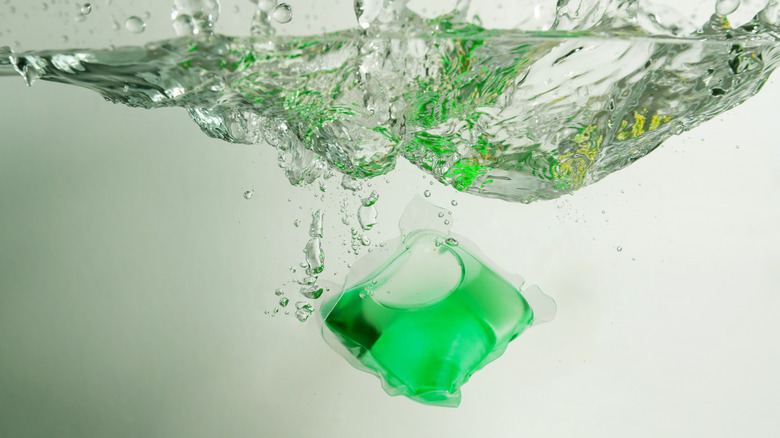What To Know About The Controversial Ingredient Lurking In Your Laundry Products
Plastics are tricky. They're omnipresent. They are infinitely useful, but also stick around infinitely in the environment. Dig deep into the ingredients lists of many items, and it shouldn't be surprising to find some sort of plastic among them. Polyvinyl alcohol, or PVA, is a polymer — technically a plastic — that's used as a binding agent in many products. One of its most prevalent uses is in dish and laundry pods and detergent sheets, where it holds the cleaning agents together until the pod or sheet comes into contact with water.
There has been growing concern about the environmental impacts of PVAs, and there is some evidence that this concern may be warranted. However, at the time of writing, neither the EPA, the European Union, or Canada is worried about this compound. In fact, PVA is listed on the EPA's Safer Chemicals Ingredients list. So, is that enough to sit back in relief? There are other reasons you should stop using laundry pods immediately, but they mainly stem from harm caused by ingesting them. Yet still, some scientists consider PVA a significant water pollutant.
If you truly love the way your laundry pods clean, but you also have worries about sustainability, learn this simple laundry pod hack that can keep bits of PVA coating from sticking around on clean clothes. Often, when your laundry pods aren't dissolving, you can adjust your water temperature or soak the pod before using to soften the plastic casing. Since there's not a solid consensus about PVA, whether you take a chance on this compound is up to you — at least until more data surfaces.
A bit more in depth on the PVA debate
PVA is a petroleum byproduct like conventional plastics, but PVA is water-soluble; this pushes it into a gray area of "Is it plastic or not?" And being soluble, does it break down reliably enough in water to avoid becoming part of the microplastics blight? Some scientists are sharing concerns that it doesn't decompose well enough to keep from contributing to plastic pollution. There are certain conditions required for the coating to dissolve; otherwise, it becomes waste that washes into the water system. You may have noticed the gelatinous residue on your clothing after washing with a laundry pod, and this could have you raising your eyebrows. Public alarm has spurred a petition to the EPA to remove PVA from their Safer Chemicals List, and a bill was proposed in New York City, hoping to ban all PVA-coated pods. Thus far, neither movement has been successful.
The American Cleaning Institute (ACI) maintains that laundry and dish products containing PVA are harmless; they present potential challenges to the research that's been conducted. The Institute also cites leading scientists who believe PVA pollution is a myth. Something to consider, however, is that the ACl's membership includes companies who produce laundry pods. Proctor and Gamble (maker of Tide Pods), Unilever, and Clorox are among the industry's heaviest-hitters and are members of the ACI. With a vested interest in keeping sales high, you may wonder how reliable a source this data may be.

